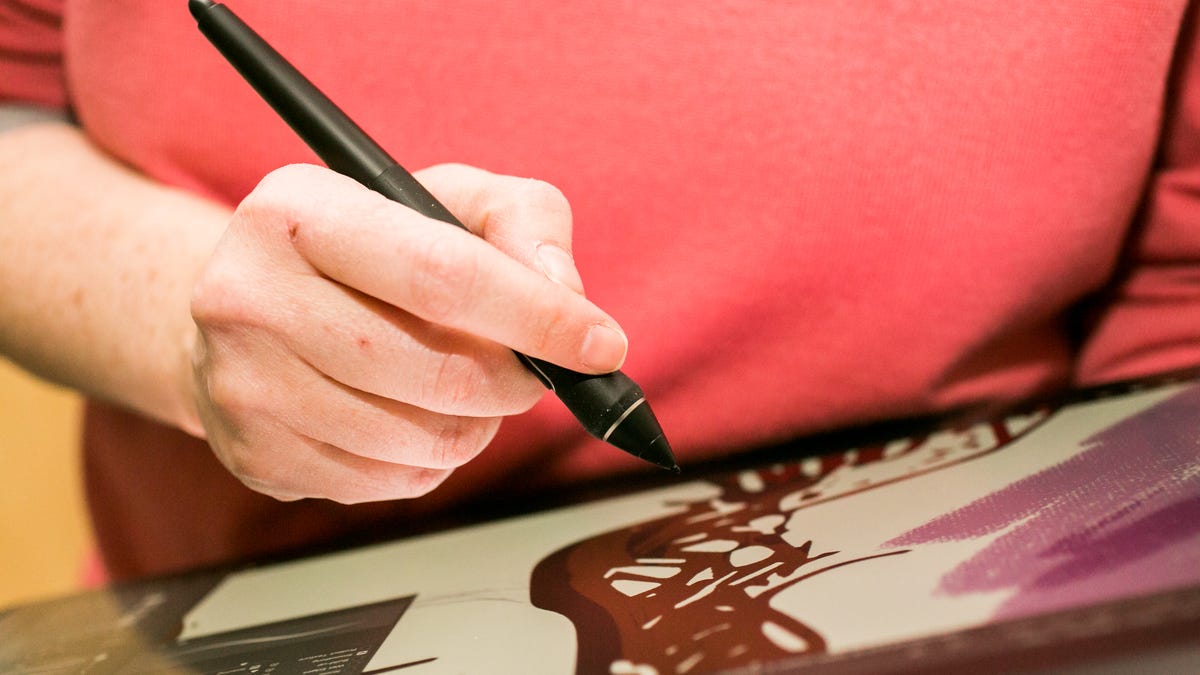 Why You Can Trust CNET
Why You Can Trust CNET Useful work-from-home gear for the quarantined creative
Stuck working at home for the first time? These may help make your makeshift photo- or video-editing setup operate a little more smoothly.

I miraculously had a Wacom MobileStudio at home, which is now serving as my second monitor.
Trying to get work done in a makeshift workspace is hard; trying to replicate your office-based professional workflow during this coronavirus and COVID-19 pandemic requires even more finesse. Here's some gear that might make it go a little more smoothly.
Hopefully, you've already bought or own the requisite laptop, desktop or tablet necessary to get your creative work done. Thanks to growing numbers of shelter-in-place/lockdown edicts, it's getting harder to get some nonesssentials shipped. In fact I can't find any of the webcams worth recommending -- many of which are Logitech's -- available to ship sooner than the next few weeks (or at all). Logitech says it's "working to meet this need as quickly as possible with increased production and distribution of our products," but that won't help you right now.
If you're stuck with a laptop that you bought for portability rather than power, consider updating its graphics subsystem with an external GPU. They aren't cheap -- the least expensive decent ones are around $300 and the prices usually don't include the graphics card -- plus compatibility can be complicated and most are targeted at gaming rather than professional use. But it's cheaper than buying a new laptop with the same graphics capabilities. Egpu.io is a good place to start your research if it's something you're ready to consider.
If you need to communicate with clients, record presentations or stream audio, you want something better than your laptop's built-in mics. It has three capsule microphones, four pickup patterns (for different kinds of recording) and just enough controls to help optimize the way you sound without overloading you with super-technical features. Plus, a standalone mic like the Nano adds a touch of class that a headset lacks when you're on video. The Nano offers a reasonable compromise between price and quality, and potentially more important, it's still available if you need something soon.
I honestly don't know how most people cope with the thimblefull of ports on laptops; a hub-slash-docking-station is essential for handling all the external displays, drives and wired peripherals surrounding me. You should buy one with the collection of ports that you need in particular -- for instance, the TS3 Plus sitting next to me has a full-size DisplayPort connector, while another model will have HDMI. It's nice for Windows' laptops, which tend to be shorter on Thunderbolt ports than MacBooks as well as newer MacBooks which lack USB-A connections. Plus, the SD card reader comes in handy.
Joby's GorillaPod line of tripods come in a zillion sizes and configurations, but they all have one thing in common: jointed legs that can wrap around irregularly shaped objects. That can be invaluable when trying to turn a cluttered, lived-in space into a makeshift photo studio, or even simply place a small light to use as a makeshift webcam light.
If you're dealing with really big files or are in the unenviable position of having to suddenly share bandwidth with kids watching Disney Plus while you're trying to edit video, a gaming router may be the answer. It's expensive, but you'll get top performance; perhaps more important, good gaming routers give you granular control over prioritization -- that way, your deadline video upload takes precedence over Frozen II.
If you work in the dark for better color accuracy and contrast, an illuminated mouse is essential. Gaming mice give you lots of control over the light -- you can usually dim them so you can still see them but the light doesn't interfere with your peripheral vision. They also tend to have finer, on-the-fly control over speed and sensitivity and smoother glide, which I've found critical when switching from photo editing to gaming to writing. lus, you can create macros and assign them to various buttons for your video or photo speed-editing needs.
The Rival 3 is a solid, inexpensive wired model. Wireless versions tend to be more expensive, but I like the $120 Rival 650 Wireless.
Like the mice, I think gaming keyboards are far better for, well, almost everything except looking thin: the controllable illumination and programmable macros are useful for the same reasons as the mouse: working in the dark and speed editing of photos and videos. I like mechanical keyboards like this inexpensive one, and Logitech makes some well-respected ones. But if you prefer something with a softer sound but a mechanically tactile feel, the $90 Steelseries Apex 5 is my current budget go-to.

